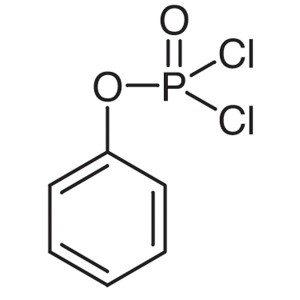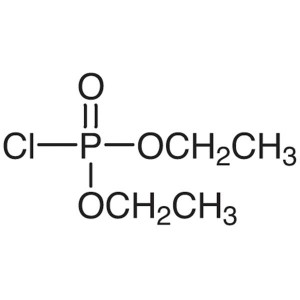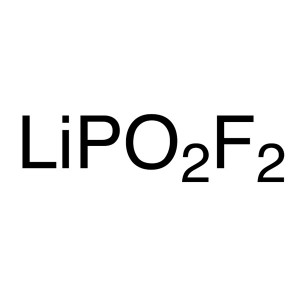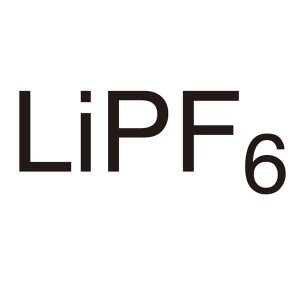Phenyl Dichlorophosphate CAS 770-12-7 Purity >99.0% (GC)
Shanghai Ruifu Chemical Co., Ltd. is the leading manufacturer of Phenyl Dichlorophosphate (PDCP) (CAS: 770-12-7) with high quality. Ruifu Chemical can provide worldwide delivery, competitive price, excellent service, small and bulk quantities available. Purchase Phenyl Dichlorophosphate, Please contact: alvin@ruifuchem.com
| Chemical Name | Phenyl Dichlorophosphate |
| Synonyms | Phenylphosphoric Acid Dichloride; Phenyl Phosphorodichloridate; Phenylphosphoryl Dichloride; PDCP |
| Stock Status | In Stock, Commercial Production |
| CAS Number | 770-12-7 |
| Molecular Formula | C6H5Cl2O2P |
| Molecular Weight | 210.98 g/mol |
| Melting Point | -1.0℃ |
| Boiling Point | 241.0~243.0℃(lit.) |
| Flash Point | 112.0℃(233°F) |
| Density | 1.412 g/mL at 25℃(lit.) |
| Refractive Index n20/D | 1.523(lit.) |
| Store Under Inert Gas | Store Under Inert Gas (Nitrogen) |
| Sensitive | Moisture Sensitive. Ambient Temperatures. |
| Water Solubility | Decomposes |
| Solubility | Soluble in Chloroform |
| COA & MSDS | Available |
| Place of Origin | Shanghai, China |
| Brand | Ruifu Chemical |
| Items | Specifications | Results |
| Appearance | Colorless Transparent Liquid | Colorless Transparent Liquid |
| Phenyl Dichlorophosphate (PDCP) | >99.0% (GC) | 99.7% |
| Phenol | <0.50% | <0.50% |
| Triphenyl Phosphate (TPP) | <1.00% | 0.03% |
| Diphenyl Chlorophosphate (DPCP) | <0.50% | 0.11% |
| Phosphorus Oxychloride (POCl3) | <0.80% | <0.80% |
| Other Single Unknown Impurity | <0.50% | 0.06% |
| Density (20℃) | 1.417~1.421 | Conforms |
| Refractive Index n20/D | 1.522~1.525 | Conforms |
| Infrared Spectrum | Conforms to Structure | Conforms |
| Conclusion | Has been tested and complies with the given specifications | |
Package: Fluorinated Bottle, 25kg/Drum, or according to customer's requirement.
Storage Condition: Moisture sensitive. Keep the container tightly closed and store in a cool, dry, well-ventilated warehouse away from incompatible substances. Keep away from sunshine; avoid fire and heat sources; avoid moisture. Incompatible with strong bases, alcohols and strong oxidizing agents.
Shipping: Deliver to worldwide by air, by FedEx / DHL Express. Provide fast and reliable delivery.
How to Purchase? Please contact Dr. Alvin Huang: sales@ruifuchem.com or alvin@ruifuchem.com
15 Years Experience? We have more than 15 years of experience in the manufacture and export of a wide range of high quality pharmaceutical intermediates or fine chemicals.
Main Markets? Sell to domestic market, North America, Europe, India, Korea, Japanese, Australia, etc.
Advantages? Superior quality, affordable price, professional services and technical support, fast delivery.
Quality Assurance? Strict quality control system. Professional equipment for analysis include NMR, LC-MS, GC, HPLC, ICP-MS, UV, IR, OR, K.F, ROI, LOD, MP, Clarity, Solubility, Microbial limit test, etc.
Samples? Most products provide free samples for quality evaluation, shipping cost should be paid by customers.
Factory Audit? Factory audit welcome. Please make an appointment in advance.
MOQ? No MOQ. Small order is acceptable.
Delivery Time? If within stock, three days delivery guaranteed.
Transportation? By Express (FedEx, DHL), by Air, by Sea.
Documents? After sales service: COA, MOA, ROS, MSDS, etc. can be provided.
Custom Synthesis? Can provide custom synthesis services to best fit your research needs.
Payment Terms? Proforma invoice will be sent first after confirmation of order, enclosed our bank information. Payment by T/T (Telex Transfer), PayPal, Western Union, etc.
Hazard Symbols C - Corrosive
Risk Codes R34 - Causes burns
R37 - Irritating to the respiratory system
Safety Description
S26 - In case of contact with eyes, rinse immediately with plenty of water and seek medical advice.
S36/37/39 - Wear suitable protective clothing, gloves and eye/face protection.
S45 - In case of accident or if you feel unwell, seek medical advice immediately (show the label whenever possible.)
UN IDs UN 3265 8/PG 2
WGK Germany 3
RTECS TD4393000
FLUKA BRAND F CODES 10
TSCA Yes
HS Code 2942000000
Hazard Class 8
Packing Group II
Phenyl Dichlorophosphate (PDCP) (CAS: 770-12-7) is an important intermediate in the synthesis of many organic compounds and is widely used in the laboratory for its various properties.
Phenyl Dichlorophosphate has been widely used in scientific research. It is used as an important intermediate in the synthesis of various chemicals, including phosphonates, phosphates, and organophosphorus compounds. Phenyl Dichlorophosphate is also used in the synthesis of various pharmaceuticals and agrochemicals, insecticides, herbicides, and flame retardants. Additionally, Phenyl Dichlorophosphate is used in the synthesis of polymers and in the production of pesticides, as well as to create new materials with improved properties.
Reagent for preparation of phosphate diesters. Phenyl phosphorodichloridate is used in the preparation of symmetrical phosphate diesters. It is used as a phosphorylating agent for alcohols and amines.
In the field of analytical chemistry, Phenyl Dichlorophosphate can be used as a standard for the detection and quantification of other organophosphorus compounds. In the field of pest control, Phenyl Dichlorophosphate can be used as an insecticide or herbicide to control the growth of unwanted plants and insects.
Phenyl Dichlorophosphate has a number of advantages for use in laboratory experiments. It is relatively stable and easy to handle, and it is widely available. Despite its many potential uses, Phenyl Dichlorophosphate also has limitations and risks. Phenyl Dichlorophosphate is highly toxic and can cause significant health risks to those who come into contact with it. Phenyl Dichlorophosphate is also highly reactive and can react with other compounds, so it must be handled with care.
Phenyl Dichlorophosphate is used for the synthesis of methylamino abamectin benzoate, the preparation of phosp horic acid diester, and also used as a coupling agent for the polymerization of sulfinic acid and ethanol, ammo nia, triol, etc.
Phenyl Dichlorophosphate (CAS: 770-12-7), An hologenated organophosphate. Organophosphates are susceptible to formation of highly toxic and flammable phosphine gas in the presence of strong reducing agents such as hydrides. Partial oxidation by oxidizing agents may result in the release of toxic phosphorus oxides.





